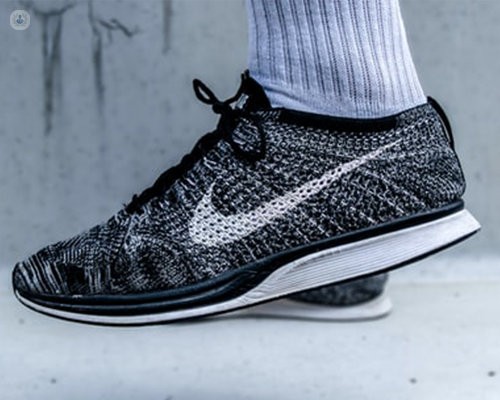Ankle sprain: treatment and complications
Autore:An ankle sprain is an injury that most people experience at some point. It can occur during exercise or innocuously when performing everyday tasks. Consultant orthopaedic surgeon and ankle specialist Mr Jordi Sanchez-Ballester answers the most pertinent questions regarding this injury.

How common are ankle injuries?
Ankle ligament injuries are extremely common, accounting for around 10% of all A&E attendances, which equates to 302,000 cases in the UK per year.
Ligaments are bands of tissue which connect our bones to each other, providing stability and strength to our joints. Ankle ligaments stop the joint from extending too far to one side. A sprain is the result of overstretching or tearing one or more of these ligaments.
How do they occur?
Ankle sprains most commonly occur when the joint is twisted with excessive force. When this happens, the joint moves in an atypical way, stretching and pulling the ligament. This can cause pain, swelling, bruising and limited movement of the joint.
How do you treat a strained or sprained ankle?
To effectively treat a sprained ankle you should:
- Keep the strained muscle around the ankle safe from further injury by wearing a protective boot or brace.
- Rest the ankle completely, keep standing and walking to a minimum, using crutches if necessary.
- Ice the affected ankle for 20 minutes every hour (make sure you wrap the ice or ice pack in a towel or something similar, never apply the ice directly to the skin).
- Gently wrap the joint with an elastic bandage. This compression provides extra support to the joint and helps reduce swelling.
Severe pain and bruising are often signs of a more serious sprain, so I would advise seeking physiotherapy advice if this occurs.
Rest and ice are usually enough for most sprains to heal, so if the swelling and pain continue, you should consult a physician. Untreated moderate or severe sprains can weaken the ankle in the long term, cause repeated sprains or other ankle injuries, and eventually cause arthritis. Acute and recurrent ankle sprains may need surgery to repair damaged ligaments or tendons.
The most common type of ankle sprain is an inversion (lateral) ankle sprain. This is when the ankle bends too far inwards (or inverting). This occurs when one or more of the ligaments which make up the lateral ligament complex, a collection of three ligaments which combine to stop the ankle inverting, overstretches or tears. More than 90% of reported ankle sprains involve this set of ligaments. Lateral ankle ligament sprains are common in young athletes.
Are there any complications?
Roughly 10-30% of patients feel ankle pain after the injury has healed and 10-40% of patients experience recurrent sprains and a lack of stability.
In order to avoid this type of recurrence, it’s recommended to do the following:
- Visit an experienced clinician who can assess the injury.
- Establish whether there is instability in the joint on the day of the injury or within 72 hours.
- The RICE method should be followed within 48 hours for minor injuries with no instability.
- Major and unstable sprains require referral to a physiotherapist and an ankle brace.
- Avoid high risk activities and try some ankle strengthening exercises.
What is chronic ankle instability?
Chronic ankle instability is when the ankle regularly feels like it’s giving way when standing, walking and performing regular activities. This can occur after an acute sprain or one that hasn’t been sufficiently treated.
If you have an injured ankle that is failing to set after 6-8 weeks, we recommend to be assessed by foot and ankle surgeon and having an MRI scan done to check over the injury. Anyone suffering with this issue can visit Mr Sanchez-Ballester's Top Doctors profile and request an appointment.


